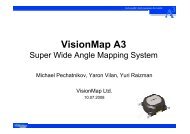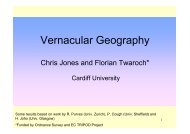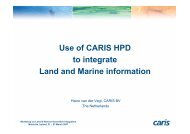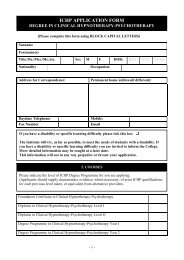EuroSDR Projects - Host Ireland
EuroSDR Projects - Host Ireland
EuroSDR Projects - Host Ireland
You also want an ePaper? Increase the reach of your titles
YUMPU automatically turns print PDFs into web optimized ePapers that Google loves.
Object-Oriented Classification of Orthophotos to<br />
support update of Spatial Databases<br />
F.P. Kressler, K. Steinnocher<br />
ARC systems research<br />
A-2444 Seibersdorf, Austria<br />
florian.kressler;klaus.steinnocher@arcs.ac.at<br />
Abstract— Interpretation of aerial images is normally carried out<br />
by visual interpretation as traditional classification routines are<br />
too limited in dealing with the complexity of very high resolution<br />
data. Segmentation based classifiers can overcome this limitation<br />
by dividing images into homogenous segments and using them as<br />
basis for further classification procedures. In this paper this<br />
approach is examined in view of its potential to support the<br />
update of existing land use data bases. A workflow was developed<br />
that allows the classification of high-resolution aerial images, the<br />
subsequent comparison with land use data and the assessment of<br />
identified changes. Special emphasis is put on the transferability<br />
of the procedure in terms of study area as well as image and land<br />
use data.<br />
Segmentation, Orthoimage, Classification, Human Settlement,<br />
Semi-automation, Change Detection, Databases<br />
Introduction<br />
Geospatial data such as cadastral maps are usually<br />
established and updated from aerial images by visual<br />
interpretation, a both time consuming and tedious task.<br />
With the advent of digital aerial images and improved<br />
analysis methodologies, semi-automated classification<br />
procedures can be an improvement both in terms of<br />
reliability as well as costs. Within the framework of<br />
<strong>EuroSDR</strong> (Spatial Data Research) the project ‘Change<br />
Detection’ was initiated to examine the update of<br />
geospatial data on the basis of digital remote sensing<br />
images, supported by semi-automated classification<br />
methodologies. Partners from Austria, Belgium, Denmark,<br />
Finland, Germany, <strong>Ireland</strong>, Switzerland and<br />
Turkey provided samples of their databases to allow an<br />
analysis whether the proposed procedure can fit the<br />
different data sets.<br />
The automated or semi-automated analysis of high<br />
resolution images has been hampered by the high<br />
complexity of such images. Traditional pixel-based<br />
classifiers such as Maximum Likelihood very often lead<br />
to an undesired speckle effect [1] as they only look at<br />
one pixel at a time without considering its spatial<br />
context. Object based classifiers deal with this problem<br />
by segmenting an image into homogenous segments<br />
prior to any classification [2]. Classification is based on<br />
M. Franzen<br />
Federal Mapping Agency<br />
A-1080 Vienna, Austria<br />
michael.franzen@bev.gv.at<br />
features calculated for each segment. These features not<br />
only draw on spectral values but may also be related to<br />
size, form, texture, neighborhood, previous classifications,<br />
and so forth. It can be seen that now much more<br />
complex classifications can be carried out, better suited<br />
to deal with very high resolution data. Although a<br />
number of object-based classification experiments have<br />
been performed (e.g. [3] and [4]), the number of applications<br />
using orthophotos is limited.<br />
Aim of this study was to develop a classification procedure<br />
for very high resolution orthophotos to support the<br />
update of existing land use data bases. As land use<br />
classes are often defined by their function rather than<br />
properties that can be observed in an image, emphasis is<br />
put on showing where changes might have taken place,<br />
leaving confirmation of these changes, determination of<br />
correct boundaries and assignment of appropriate labels<br />
to the user. Development of the classification procedure<br />
was based on real-color orthophotos from Austria. In a<br />
next step the procedure was tested on data from Denmark,<br />
Germany and Switzerland. Although both images<br />
as well as land use data are quite different from those<br />
used for Austria, the procedure could be adapted very<br />
easily to suit the new data sets.<br />
Data sets and study areas<br />
For the development of the methodology 15 real color<br />
orthophotos from 2004, recorded over the towns of<br />
Weinitzen and Wenisbuch near Graz, Austria were used.<br />
Each orthophoto covers 1.25 x 1 km with a spatial<br />
resolution of 25 cm. The Digital Cadastral Map was used<br />
as reference data. This data set comprises 34 classes, 21<br />
of which were present in the study area. In addition data<br />
sets from Switzerland, Germany and Denmark were<br />
examined (see Table 1). For Switzerland 3 real color<br />
orthophotos (spatial resolution 0.5 m) recorded in 1998<br />
and reference data from 1993 were available, covering<br />
3 x 3 km each. The reference data stems from the Digital<br />
Landscape Model of Switzerland. For Germany one real<br />
color orthophoto with a spatial resolution of 0.4 m,<br />
167









